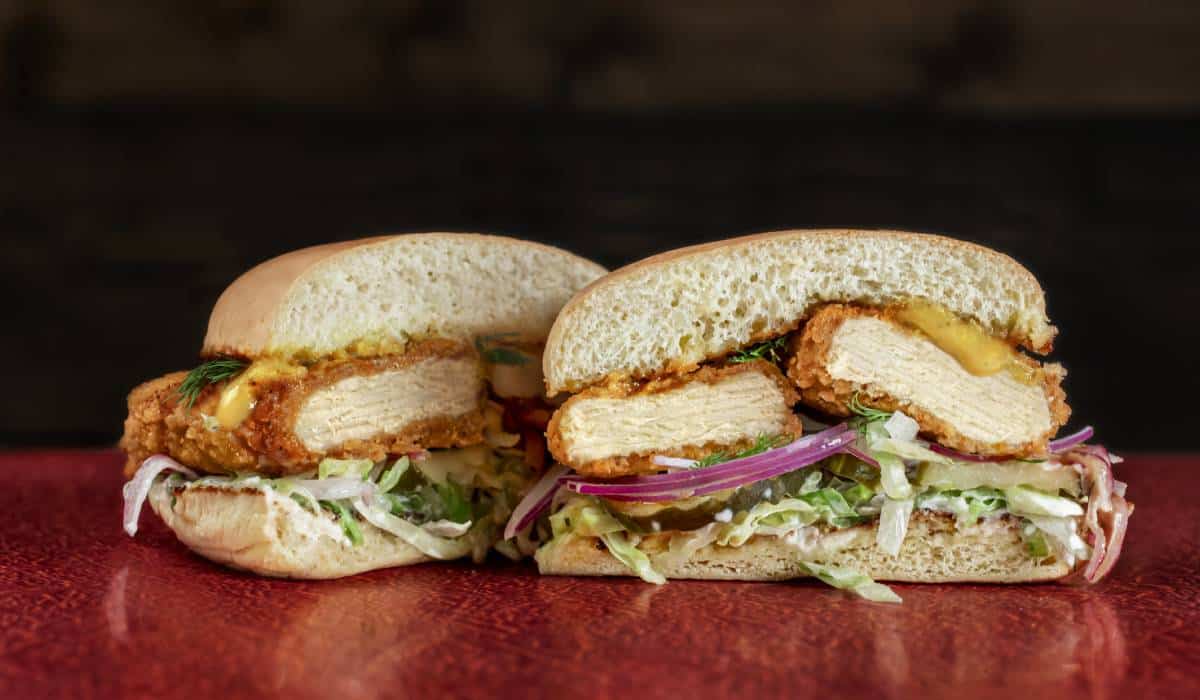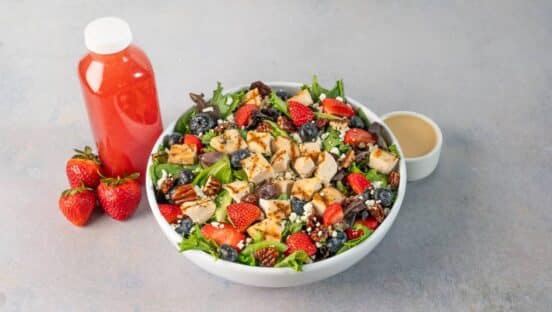The pandemic disrupted much of consumer behavior, but the tide was already turning when it came to meat alternatives.
Even more so today than pre-COVID-19, health and sustainability are top of mind for diners, says Tim Smith, Beyond Meat’s VP of food service North America. As consumers become increasingly aware of the health and environmental implications of their food choices, they are looking closer at concerns associated with animal protein.
“We believe there is a better way to feed our future and that the small everyday choices made by individuals, such as shifting the protein at the center of the plate to plant-based meat, can have a great impact on our personal health and the health of our planet,” Smith says.
In 2019 and 2020, plant protein grew at an explosive pace, consistently in double digits, year-over-year. According to the Good Food Institute, the retail market for plant-based foods is worth $7 billion, and plant-based food dollar sales jumped 27 percent in the past year.
The reasons why don’t appear short-term: plant-based meat alternatives present a lower environmental footprint and an attempt to catch up with competitors. In quick service, this could mean capturing some of the market share of fast casuals.
McDonald’s, A&W, Burger King, Carl’s Jr, Wendy’s, Subway, and Nathan’s Famous all either launched or are currently testing plant-based meat alternatives. The menu items can be a strong indicator of brands that will “walk the talk” of environmental sustainability practices.
Even throughout COVID, when comfort food reigned supreme, Smith says Beyond Meat witnessed consistent progress in household penetration and repeat rates of sales. The Beyond Burger is perhaps the company’s most notable contribution to the movement, offering 20 grams of protein derived from peas and rice with 35 percent less total and saturated fat, as well as fewer calories than 80/20 beef.
Beyond Meat products are available at roughly 130,000 retail and foodservice outlets in more than 90 countries worldwide.
While replacing animal-based meat with Beyond Meat in an eight-week Stanford University study, participants saw lowered levels of LDL cholesterol, sometimes known as “bad” cholesterol. And on average, participants lost 2 pounds.
Likewise, Incogmeato, Lightlife, and Impossible Foods are seeing a steady flow of repeat customers and restaurant operator interest.
Impossible Foods grew from being in nearly 150 grocery stores at the start of the pandemic to more than 22,000 today. The brand is also sold at close to 40,000 restaurants and counting and did not slow down last year. Dennis Woodside, Impossible Foods’ president, says the company experienced an 85 percent growth spike in quarterly retail revenue, a tripling of household penetration over the past year, and a significant jump in volume and velocity at retail stores.
“Our differentiator is that our products are designed to replicate meat at the molecular level based on fundamental science and innovation, so they deliver the taste, texture and cooking characteristics that meat eaters crave,” Woodside says.
Dara Schuster, senior director of marketing at the Frozen Portfolio of Kellogg Company who oversees Incogmeato, says non-meat options are no longer only for vegetarians and vegans, either. There’s been a huge influx of “flexitarian” consumers for a variety of reasons: affordability, nutrition, and especially of late, environmental impact.
Sustainability has become a higher focus of consumers when purchasing plant-based foods, she says. It wasn’t even in the top-five purchase drivers when the Impossible Burger came on the scene in 2016, but now it’s consistently included in the top three.
When adults consume a meatless meal versus one with meat, the impact on the environment is at least 40 percent less, on average, according to the 2016 Comparative Life Cycle Assessment of Plant-Based Foods and Meat Foods Summary from Quantis & MorningStar Farms.
In fact, by eating plant-based just once a week, consumers can save 1,000 square feet of land, 200 showers worth of water, and 184 miles of greenhouse car emissions.
“As consumers look for more diverse protein options, restaurants that provide these options can stay ahead of the curve,” Smith says. “At Beyond Meat, we create products that enable people to eat what they love, like a juicy, delicious burger at their favorite restaurant, without having to compromise on taste, health or sustainability.”
But past providing what may be considered healthier or more sustainable options, restaurant operators can incorporate plant-based meats to attract a new type of customer, especially within the Gen Z cohort. Piper Sandler’s annual teen survey found Beyond Meat and Impossible Foods were go-to brands among the group. Roughly 47 percent of Impossible customers are millennials or Gen Z, Woodside says.
“Younger consumers, like Gen Z, are increasingly aware of the environmental implications of their food choices and are voting with their dollars by supporting brands that align with their ideals,” Smith says. “It’s expensive to buy an electric car, but for roughly $6 a consumer can buy the Beyond Burger and make a powerful statement about what they believe in.”
Drawing in the support of younger generations requires incorporating interesting flavor profiles alongside plant-based meat options, Schuster adds.
“Gen Z and Gen Alpha are foodies—they’ve been exposed to a wide array of food even at a young age,” Schuster says. “To meet their cravings, we have to incorporate trending flavor profiles and new ingredients while also balancing the cost of any menu item.”
One way to do that is to develop recipes that incorporate globally inspired flavors, she says.
When the Beyond brand name is leveraged on menus, Smith says, restaurants experience a strong lift in sales. Customers who are more aware of the environmental impacts will likely continue to seek out restaurants with eco-friendly offerings, which often excludes the traditional cheeseburger.
Beyond Burgers, for instance, use 99 percent less water, 93 percent less land, nearly 50 percent less energy, and generate 90 percent fewer greenhouse gas emissions than the production of a quarter pound U.S. beef burger, according to a study by the University of Michigan.
Woodside says eating plant-based is a way to significantly curb future greenhouse gas emissions, and it can happen without making any changes to humans’ global transportation or energy habits.
“Using our food system as a tool to address the world’s climate issues is an extraordinary and untapped opportunity for positive, consumer-driven change,” Woodside says. “While many consumers are not fully aware of the connection between their personal eating habits and their individual climate impact, transitioning away from animal agriculture should be viewed as humanity’s single most powerful way to put the brakes on climate change.”
While some chefs may display hesitation, Schuster says plant-based proteins are versatile across menus and can easily be swapped as a protein of choice in recipes. More than one in four customers said they wanted more plant-based protein menu options in a 2019 Plant-Based Protein Study from Datassential.
“We know that many chef operators are cautious to add plant-based alternatives, fearing the product won’t perform back-of-house or drive traffic and sales,” Schuster says. “However, the reality is the opposite. Plant-based options offer operators not only consistent quality and performance, but also versatility across dayparts.”
Impossible Foods’ Woodside echoes this sentiment. Those who do order a plant-based meat are likely to do so again: 84 percent of customers who order the Impossible Burger say they are likely to order it again within the next three months, he says, based on research.
Looking ahead, the brands say there are only new heights to reach in plant-based meat’s growth trajectory.
Lightlife, for example, aims to make its plant-based proteins, ranging from burgers to hot dogs, tempeh to sausage and chicken, more accessible to consumers through variety.
“We know that the consumer desire for high-quality, sustainable and plant-based protein alternatives is as prevalent as ever, so to address this need, Lightlife has heavily invested to completely overhaul its portfolio of products in just over one year to remove ingredients like eggs and maltodextrin, and as a result, raise the bar for other brands in the category to do the same,” says a Lightlife brand spokesperson.
The brand has partnered with KFC and Canadian pizza chain Pizza Pizza to provide chicken-like alternatives, while its burgers are live in U.S. Spotless Burger locations and Harvey’s Restaurant units across Canada.
In October, Whole Foods Market became the first retailer to offer Lightlife’s unbreaded plant-based chicken product in more than 500 prepared foods departments in the U.S. and Canada. And in 2022, Lightlife will expand distribution of its Plant-Based Tenders, Plant-Based Fillets and Plant-Based breakfast products across the United States and Canada with product launches at 7-Eleven Canada, Mary Brown’s and others.
Lightlife is also building what the brand says will be the largest tempeh production facility in North America at 118,000 square feet, capable of producing 10 million pounds of Lightlife tempeh.
It’s important to note, restaurants are still operating with limited menus and labor shortages, Schuster says, but she anticipates plant-based protein will grow in restaurants as consumers move away from pandemic indulgence and toward routine and health-forward choices. Incogmeato launched a Homestyle Chik’n Tenders product that Turkey and the Wolf, a New Orleans-based restaurant, serves regularly.
Impossible Foods aims to “be everywhere,” Woodside says, in every market globally, and with a full array of products for every culture and cuisine, ultimately scaling to produce over a trillion pounds of “meat” by 2035.
Perhaps most alluring, Woodside says, Impossible Foods is actually beating meat from animals on taste. In a blind consumer taste test, seven out of 10 consumers preferred Impossible Chicken Nuggets over animal chicken nuggets from a leading brand, with the Impossible product scoring higher in flavor, texture, and overall appearance.
“This is the first time we’re aware of where the plant-based product is being chosen by consumers as being decidedly better tasting than the real thing,” Woodside says. Impossible pork and sausage also received similar rankings in consumer tests.
Already offering beef, pork and chicken substitutes as well, Beyond Meat is also dedicated to future innovation as there is room for increased market capture.
“We know that to win, we have to focus on three key levers: taste, nutrition, and price,” Smith says. “If we can get it to taste just as good as meat, be better for you and ultimately, be cheaper, we see a huge opportunity to transition consumers to plant-based meat.”











